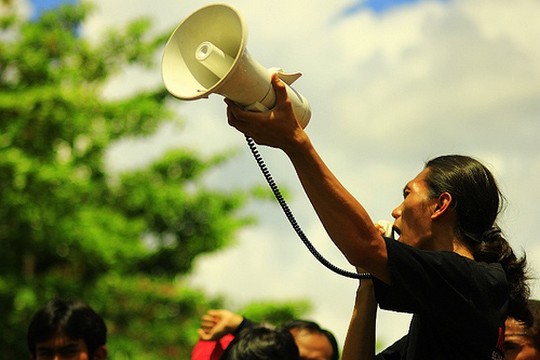Indonesia is Facebooking, Twittering and blogging, but what effect is this having on campaigns for social justice?
Thushara Dibley
Indonesia is online. The number of Indonesians using the internet increased from two million in 2000 to over 55 million in 2012, the fourth largest number of internet users in Asia (after China, India and Japan).
This phenomenal growth in access to the internet has been supported by a rapidly growing economy as well as the widespread uptake of mobile phone technology. In 2011 a Nielsen report indicated that 48 per cent of Indonesia’s internet users went online via their mobile phones and another 13 per cent used some other type of handheld device.
Indonesian ‘netizens’ have also keenly taken to new social media sites like Facebook, Twitter and the blogosphere. In fact, Indonesians are the fourth biggest users of Facebook and the fifth biggest users of Twitter worldwide. Globally, these sites have received increasing attention as tools for activism. The Arab Spring protests, the Kony 2012 phenomenon and the Occupy Movement are frequently cited as examples of movements facilitated by the internet. But to what extent have these tools been used by activists in Indonesia? Have they taken up online mediums to campaign for change? If so, how successful are their efforts?
This edition provides a snapshot of the multitude of ways that Indonesian activists, politicians and ordinary citizens use new social media as a tool for activism. The contributors to this edition explore the diverse ways that this popular medium is used to affect change, but also question its effectiveness as a means to address issues of social justice.
Ross Tapsell opens this edition with a discussion of how the convergence of mainstream media with social media is creating opportunities for ordinary citizens and activists to direct media attention to issues that are of importance to them. While there is the potential for media convergence to result in the restriction of how social media is used, Tapsell suggests that the widespread use of social media and its growing popularity mean that mainstream news sources in Indonesia are being forced to become more flexible and responsive to their readers’ concerns. On a similar theme, Wayne Palmer paints an optimistic picture of how Twitter is being used by middle-class Indonesians to influence mainstream politics, showing how it has opened channels for ordinary citizens to express their views about politicians. He highlights how Indonesian politicians have been able to take advantage of this tool to increase their public profile but, at the same time, are now more accountable as a result of how the Indonesian public monitor their behaviour online.
The following two articles focus on how activists in particular sectors make use of the online medium to promote their causes. Rebekah Moore explores how grunge band, Navicula, has used the internet to promote its message of social justice. Moore argues that, despite being on the fringe of the music industry, Navicula has been able to successfully use social media and other online tools to spread its message of the importance of environmental justice. In their piece, Rikky Muchammad Fajar and Alexandra Crosby focus on how lesbian, gay, bisexual and transgender (LGBT) activists in Indonesia have embraced the online medium as a means to engage in activism. The online space has become one of the key safe spaces for LGBT activism in Indonesia as the legal context makes it increasingly challenging for these activists to campaign for their rights.
The final two articles in the edition take a more critical perspective. Yanuar Nugroho, who is critical of the lack of strategic thought invested into online activism in Indonesia, illustrates how poorly conceived social media campaigns can raise expectations of change that are not matched by results in the off-line world. Finally, Arjuna Dibley analyses the high profile Prita Mulyasari case and what it reveals about the ability of social media activism to lead to legal reform. He argues that the short, catchy messages that social media activists rely on have just not been enough to lead to substantive changes in Indonesia’s legal system.
The articles in this edition show that social media tools have allowed ordinary citizens, activists and artists to engage with political issues in new and creative ways. While the contributors don’t necessarily agree about the extent to which these tools have been successful, this edition makes it clear that the digital age is making its mark on social activism in Indonesia.
Thushara Dibley (thushdibley@gmail.com) is an Honorary Associate of the Department of Indonesian Studies at the University of Sydney and Visiting Researcher at the Program for Arms Control, Disarmament and International Security at the University of Illinois at Urbana-Champaign. Her research is about NGOs, peacebuilding and social movements in Southeast Asia.
